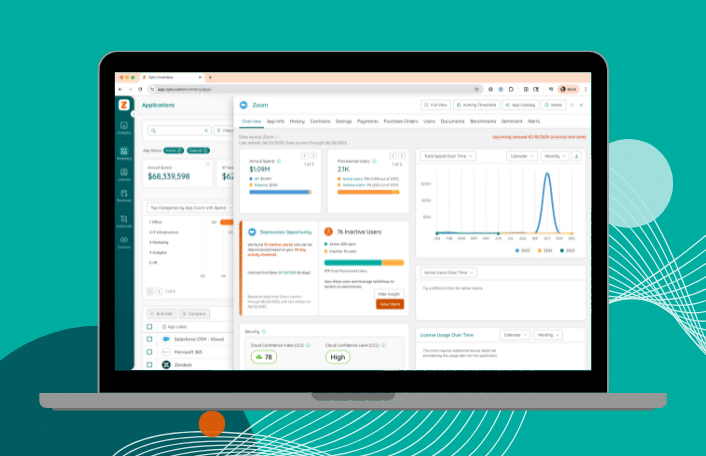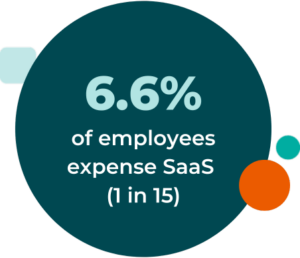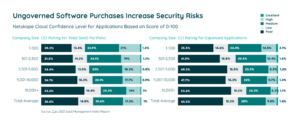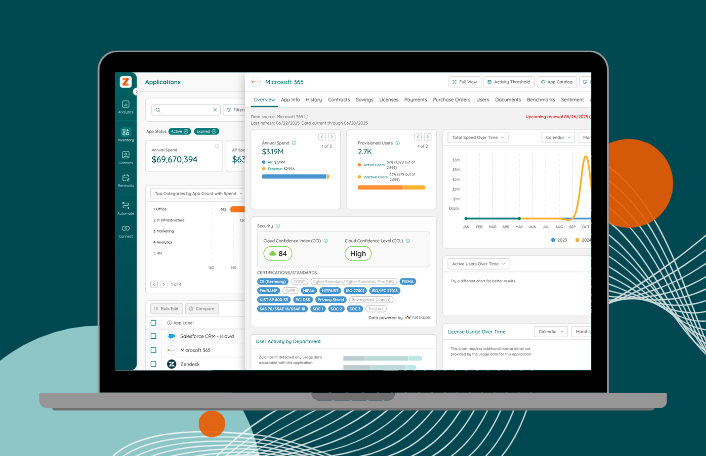
The IT & SAM Leader’s Guide to Smarter Zoom License Management
Table of Contents ToggleWhat Is a SaaS License?Why Managing SaaS Licenses...
Back
Back
Search for Keywords...
Blog

Table of Contents
Companies are buying SaaS (software-as-a-service) like never before. According to Gartner’s predictions, the SaaS market is projected to grow by 19.2% to a total of $299 billion in 2025—up from $247B in 2024.
What’s most notable, however, isn’t the growth of the SaaS space— it’s how quickly companies accumulate new applications, subscriptions, and licenses. When we’re talking about the average organization running hundreds of apps, that’s a lot of licenses to manage. Zylo data reveals that the average SaaS portfolio inventory is 275 applications.

Something important often gets lost when discussing the sheer volume of applications: SaaS licenses and the sometimes-confusing “legalese” involved with managing enterprise software. This post will break down what goes into a SaaS license and why understanding licensing agreements matters.
Let’s highlight how the SaaS license model works in layman’s terms.
Unlike a perpetual license agreement (which involves one-time payment and full ownership of software), a SaaS license is an ongoing commitment for as long as you pay for the service. Your license is essentially bundled with your SaaS subscription.
When you subscribe to a service, you can access that product’s updates, latest features, and support staff. Arguably, the biggest bonus of a SaaS license is not being responsible for the upkeep of servers or data. This advantage makes SaaS more affordable and more manageable for most companies.
Various software licensing models are available for SaaS, but most operate on an annual or monthly subscription. The advantages and downsides of this arrangement might seem straightforward at first glance. However, SaaS licenses can cause headaches in large organizations, depending on how they manage IT assets, specifically SaaS.
 How? Consider that acquisition and ownership of licenses are no longer necessarily managed by IT teams. Instead, as product-led growth has become the mantra for SaaS title makers, individual business units and employees now make up a significant portion of direct SaaS purchases. In fact, nearly 1 in 15 employees (6.6%) expense SaaS of their own accord, unvetted by IT. Multiple teams tied to so many services and licenses result in significant overlap and waste.
How? Consider that acquisition and ownership of licenses are no longer necessarily managed by IT teams. Instead, as product-led growth has become the mantra for SaaS title makers, individual business units and employees now make up a significant portion of direct SaaS purchases. In fact, nearly 1 in 15 employees (6.6%) expense SaaS of their own accord, unvetted by IT. Multiple teams tied to so many services and licenses result in significant overlap and waste.
Your company may be used to managing software with software asset management (SAM) processes. If so, then adjusting to a cloud software license strategy instead of an on-premises license management strategy can be challenging. Missed renewals, shadow IT, and unvetted apps proliferate without full visibility and a single source of truth.
Despite these issues, the ease of use, affordability, and growth of SaaS tools typically outweigh the potential cons related to licensing.
Let’s say you’re part of an organization juggling a variety of SaaS tools—as most companies are. Having multiple SaaS licenses presents a distinct set of challenges to IT leaders. Below is a breakdown of the potential risks and pitfalls of poor software license management.
SaaS licenses are easy to acquire and deploy. While that’s typically a benefit of SaaS, IT teams aren’t always aware of products employees purchase without IT’s approval. This phenomenon is known as shadow IT, which accounts for 3.8% of spend and 33.6% of applications.

The most obvious problems associated with shadow IT include wasted money and resources. For example, a company might purchase a new subscription or license for a product it already owns. If you consider the average company spends $49M on SaaS, that means $1.9M of spending is shadow IT.
When employees lead the software purchasing process, they get a license on a single-user basis. Often, this means forgoing potential volume discounts for enterprise-level buyers. Redundant or duplicate purchases become frequent if teams or employees purchase new applications without first evaluating the current software inventory.
Potential overlap between products and their peripheral features is a well-known attribute of SaaS subscription models, as title makers compete to earn best-of-breed status. While this benefits software innovation, a lack of visibility into existing tools can lead to employees purchasing solutions already served by existing licenses.
Employee-purchased SaaS doesn’t undergo the same vetting and security checks as an application purchased by IT. Lack of vetting can expose companies to risks of data breaches or compliance issues related to regulations such as GDPR, HIPAA, or CCPA.
Zylo data shows that the greatest risk lies with shadow IT—software expensed by employees. In fact, 60.8% of expensed SaaS has a “Poor” or “Low” security score. Such problems can quickly fly under the radar, highlighting how overlooking your SaaS licenses can result in severe consequences.

 According to the 2025 SaaS Management Index, only 47% of SaaS licenses are used, leaving 53% wasted, which amounts to $21M annually. Couple that with the fact that most SaaS customers log into or access a product less than once per month. If your organization doesn’t have full visibility into how employees use applications and how often, you’re likely letting your software budget go to waste.
According to the 2025 SaaS Management Index, only 47% of SaaS licenses are used, leaving 53% wasted, which amounts to $21M annually. Couple that with the fact that most SaaS customers log into or access a product less than once per month. If your organization doesn’t have full visibility into how employees use applications and how often, you’re likely letting your software budget go to waste.
License renewals can also creep up on your company if you aren’t careful. SaaS licenses frequently include automatic renewal clauses. If you aren’t actively managing your licenses, it’s easy to accidentally re-up software your company doesn’t want or need.
It seems like a lot of gloom and doom, but if you create proactive strategies for purchasing SaaS licenses and ensure they go through the right channels, you can avoid most of these issues.
Modern organizations rely on a wide range of Software as a Service (SaaS) solutions to power their operations. According to the Zylo 2025 SaaS Management Index, the average organization now maintains 275 SaaS applications. These applications often come with varied licensing options, which can significantly influence everything from budgeting to compliance. Below are some of the most common types of SaaS license models.
Under the per-user licensing model, each individual requires their own license. This structure simplifies budgeting because the total cost directly correlates to the headcount using the software. Organizations can more easily project expenses as teams grow or change. However, it’s also vital to track license usage to prevent overspending or leftover seats.
Also known as consumption-based licensing, usage-based licensing determines costs based on actual usage metrics, such as data processed or transactions made. AI capabilities are rapidly increasing the popularity of this model, as applications that leverage machine learning or large-scale data processing often incur variable costs. By aligning pricing with real-time consumption, businesses can scale AI-driven SaaS solutions without paying for capacity they don’t use.
This model remains a core approach across many industries. Customers pay recurring fees—monthly, quarterly, or annually—granting them access to the latest version of the software. This works well for businesses that prefer predictable, recurring payments. It also allows SaaS providers to incorporate seamless software updates and new features without imposing significant overhead on customers.
Becoming more common, freemium licensing offers a basic version of the service at no cost, with the option to upgrade to paid tiers for advanced functionalities. This approach enables wide adoption while generating revenue from users needing premium features. It’s common among startups looking to grow brand awareness quickly.
Per-feature licensing charges customers based on the modules or capabilities they activate. This option allows businesses to pay only for features that are relevant to their operations, ensuring tighter control over costs. It also presents a path for gradual expansion as organizational needs evolve.
A flat-rate license provides a single, all-inclusive price covering access for an entire organization or a large subset of users. Companies that require universal access to a SaaS product can benefit from this approach, particularly when they expect broad usage and want streamlined billing.
Tiered pricing packages bundle functionality into distinct levels—often labeled as Basic, Standard, and Premium tiers. Users can move up a tier as needs grow to unlock new capabilities and increased usage limits. This tier structure gives customers flexibility and enables providers to serve multiple market segments with a single product.
Similar to per-feature licensing, pay-per-feature models charge on individual functionalities. The difference is that pricing is often granular, allowing customers to add specific features as needed. This tactic benefits businesses seeking to minimize costs by paying only for the precise functions they require at any given time.
A perpetual software license often represents a one-time purchase that grants indefinite use of a specific software release. Although the purchase secures the ownership of that version, organizations may face separate fees for ongoing maintenance and support.
In contrast, a SaaS license model requires recurring payments—often monthly or annually—covering usage and continuous support, security patches, and feature upgrades.
With a perpetual license, businesses invest a larger sum at the outset and then pay maintenance costs over time. The software version remains static unless the company opts to purchase upgrades. A SaaS license involves predictable recurring fees that spread costs more evenly. This structure can streamline budgeting and simplify aligning expenses with shifting business needs.
These are typically add-on costs with perpetual licensing, and organizations must handle updates manually or pay for upgraded versions. SaaS licensing, on the other hand, includes updates, patches, and support in one bundle. This approach reduces the burden on internal IT teams, ensuring software remains secure and updated.
SaaS offers agility for companies experiencing frequent changes—like onboarding new employees or adding features. You can adjust subscription tiers or add licenses at any time. A perpetual license can become restrictive if the business outgrows the original purchase or needs new features included in more recent software versions.
It’s important to evaluate the overall cost of ownership for both perpetual and SaaS licenses. Perpetual licensing may have lower costs over a long period if usage remains stable, while SaaS ensures a consistent outlay that includes upgrades. When factoring in maintenance, support, and potential hardware requirements, SaaS can be more cost-effective for many organizations.
A perpetual license places more responsibility on internal teams to ensure the software complies with evolving regulations. By contrast, SaaS providers handle compliance updates on behalf of customers, helping businesses mitigate risks associated with outdated software or security vulnerabilities. This shift can help companies maintain consistent standards without additional overhead.
Enterprise licenses are designed to cover a broad segment—or sometimes all—of an organization’s users. These agreements typically provide a single contract for extensive access to software, often with volume-based discounts for larger purchasing power.
Enterprise licenses can include negotiable terms regarding data privacy, security measures, and service-level expectations. This collective coverage also helps avoid managing numerous individual licenses.
End-user licenses, on the other hand, serve individual usage. Also known as click-through agreements or EULAs, these are the out-of-the-box terms software providers present when a user downloads or installs an application.
If you’ve ever scrolled through “walls of text” and checked an “I agree” box during a software installation, you’ve encountered a standard EULA. While EULAs enable near-instant access, they rarely offer opportunities to adjust language around data handling or privacy. That’s because individuals—unlike large enterprises—generally don’t have the buying power to negotiate terms.
A business spending tens of thousands of dollars on software subscriptions may negotiate lower unit costs, more comprehensive customer service, or more flexible terms. By contrast, the individual user paying a small amount per month has minimal leverage to change the fine print.
From a management perspective, EULAs also mean juggling multiple licenses whenever teams grow or adopt new tools, whereas an enterprise license can streamline deployment and administration under one contract.
SaaS license agreements establish the legal framework governing the use of cloud-based software. These agreements define the rights and responsibilities of both the provider and the customer. Below are key legal considerations organizations should review before agreeing to SaaS terms.
Negotiating a SaaS license agreement is about more than just securing the right price—it’s an opportunity to tailor terms that align with an organization’s operational, financial, and compliance needs. With companies managing so many SaaS applications, having a strategic approach to negotiations can lead to better pricing, increased flexibility, and improved contract terms.
Understanding industry benchmarks is essential for negotiating favorable SaaS agreements. Companies with insights into average pricing, discount structures, and renewal trends can confidently approach negotiations. Leveraging real-world data on SaaS spending helps organizations determine whether they are overpaying or securing competitive rates.

Standard SaaS contracts often include pre-set terms, but businesses should push for flexibility that reflects their specific requirements. Key areas to negotiate include:
Many organizations struggle with complex SaaS contracts and fluctuating license costs. Zylo’s SaaS Negotiator services help businesses leverage benchmark data, evaluate contract terms, and maximize savings opportunities during renewals and new purchases. By utilizing expert negotiators, companies can identify cost-saving strategies they might not have considered on their own.
With SaaS portfolios growing year over year, companies must adopt strategies to control costs, maintain compliance, and optimize usage. Below are key tips for managing SaaS licenses effectively.
A routine audit helps organizations identify unused or redundant licenses and eliminate shadow IT. By assessing application usage, IT and Procurement teams can determine whether employees are actively engaging with licensed software or if consolidation is needed.
Modernizing Medicine (ModMed) faced challenges with disparate applications and data, making it difficult to identify and remove waste from their inventory. By implementing a centralized platform, they gained accurate and timely data, enabling them to manage their SaaS licenses more effectively.
ModMed Drives Operational Excellence & Million-Dollar Savings with Zylo SaaS License Management
Discover how ModMed used Zylo’s powerful license tracking and optimization to save millions of dollars, drive operational excellence, and improve the employee experience.
Identifying underutilized licenses allows companies to adjust their subscriptions based on actual usage. This practice prevents waste and ensures that software expenses directly contribute to productivity.
For example, ModMed used automated deprovision workflows to reclaim 2,800 unused licenses, resulting in $1.4 million in cost avoidance.
Eliminating redundant applications reduces costs and simplifies the software environment. Once you have full visibility, you can examine where you have redundancy, understand the apps that are driving value, and determine which to deprecate. While straightforward in theory, rationalization takes time and careful thought to implement, as employees like to keep their favorite tools.
With the right strategy, rationalization can be effective. Continuing with our example, once ModMed centralized all its SaaS apps and data, it helped inform the cancellation of 122 unused applications, achieving $1.6 million in cost savings.
Implementing SSO enhances security and simplifies user access management. ModMed secured 156 applications behind SSO, streamlining access control and improving security posture.
By adopting these strategies, businesses can reduce unnecessary expenses, improve efficiency, and maximize the value of their software investments.
SaaS has transformed how businesses operate, offering flexibility and efficiency for IT managers and employees. However, this ease of access can lead to challenges if organizations fail to track and optimize their licenses effectiv ely. Unused or redundant licenses, unclear ownership, and auto-renewals can quickly inflate costs and create unnecessary complexity.
With Zylo, businesses gain visibility into their entire SaaS portfolio, ensuring every license is accounted for, optimized, and aligned with company needs. By leveraging automated workflows and real-time insights, IT teams can eliminate wasted spend, improve security, and simplify license management—without second-guessing their data.
Ready to take control of your SaaS licenses? Take an interactive tour of Zylo’s License Management solution and see what it can do for your company.

Table of Contents ToggleWhat Is a SaaS License?Why Managing SaaS Licenses...

Table of Contents ToggleHow FinOps Teams Commonly Understand SaaS—and What’s MissingSaaS...

Table of Contents ToggleWhat Is an E-Commerce Tech Stack?Why Your E-commerce...

Table of Contents ToggleWhat Is a SaaS License?Why Managing SaaS Licenses...
| Cookie | Duration | Description |
|---|---|---|
| cookielawinfo-checkbox-analytics | 11 months | This cookie is set by GDPR Cookie Consent plugin. The cookie is used to store the user consent for the cookies in the category "Analytics". |
| cookielawinfo-checkbox-functional | 11 months | The cookie is set by GDPR cookie consent to record the user consent for the cookies in the category "Functional". |
| cookielawinfo-checkbox-necessary | 11 months | This cookie is set by GDPR Cookie Consent plugin. The cookies is used to store the user consent for the cookies in the category "Necessary". |
| cookielawinfo-checkbox-others | 11 months | This cookie is set by GDPR Cookie Consent plugin. The cookie is used to store the user consent for the cookies in the category "Other. |
| cookielawinfo-checkbox-performance | 11 months | This cookie is set by GDPR Cookie Consent plugin. The cookie is used to store the user consent for the cookies in the category "Performance". |
| viewed_cookie_policy | 11 months | The cookie is set by the GDPR Cookie Consent plugin and is used to store whether or not user has consented to the use of cookies. It does not store any personal data. |
